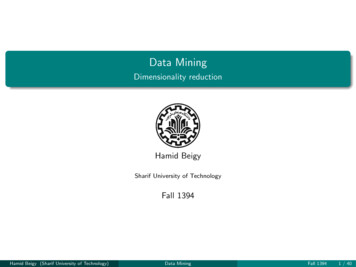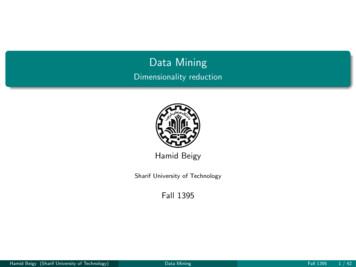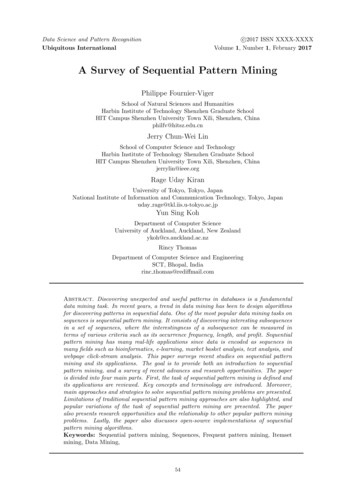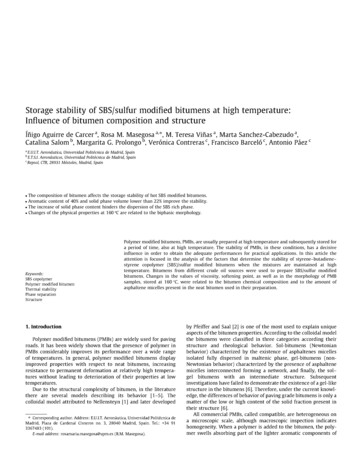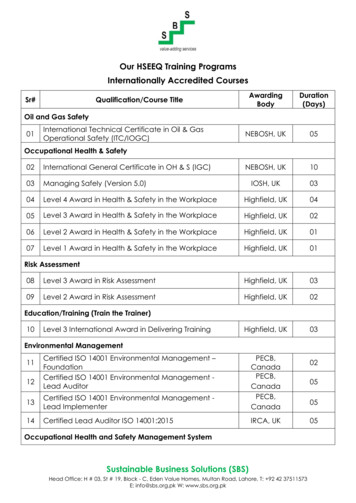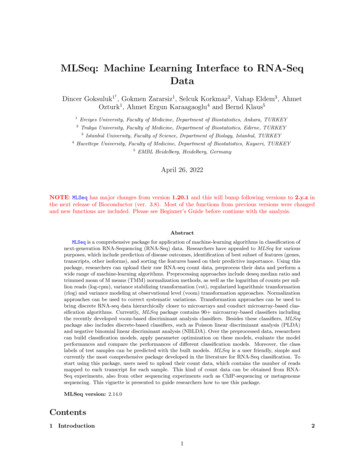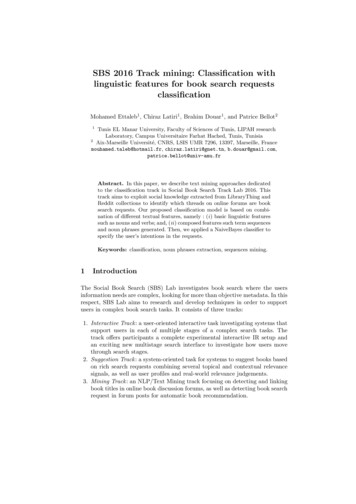
Transcription
SBS 2016 Track mining: Classification withlinguistic features for book search requestsclassificationMohamed Ettaleb1 , Chiraz Latiri1 , Brahim Douar1 , and Patrice Bellot21Tunis EL Manar University, Faculty of Sciences of Tunis, LIPAH researchLaboratory, Campus Universitaire Farhat Hached, Tunis, Tunisia2Aix-Marseille Université, CNRS, LSIS UMR 7296, 13397, Marseille, Francemouhamed.taleb@hotmail.fr, chiraz.latiri@gnet.tn, ct. In this paper, we describe text mining approaches dedicatedto the classification track in Social Book Search Track Lab 2016. Thistrack aims to exploit social knowledge extracted from LibraryThing andReddit collections to identify which threads on online forums are booksearch requests. Our proposed classification model is based on combination of different textual features, namely : (i) basic linguistic featuressuch as nouns and verbs; and, (ii) composed features such term sequencesand noun phrases generated. Then, we applied a NaiveBayes classifier tospecify the user’s intentions in the requests.Keywords: classification, noun phrases extraction, sequences mining.1IntroductionThe Social Book Search (SBS) Lab investigates book search where the usersinformation needs are complex, looking for more than objective metadata. In thisrespect, SBS Lab aims to research and develop techniques in order to supportusers in complex book search tasks. It consists of three tracks:1. Interactive Track : a user-oriented interactive task investigating systems thatsupport users in each of multiple stages of a complex search tasks. Thetrack offers participants a complete experimental interactive IR setup andan exciting new multistage search interface to investigate how users movethrough search stages.2. Suggestion Track : a system-oriented task for systems to suggest books basedon rich search requests combining several topical and contextual relevancesignals, as well as user profiles and real-world relevance judgements.3. Mining Track : an NLP/Text Mining track focusing on detecting and linkingbook titles in online book discussion forums, as well as detecting book searchrequest in forum posts for automatic book recommendation.
In this paper, we only consider the mining track which is a new one in SBS2016 edition and investigates two tasks : (i ) Classification task : how Information Retrieval Systems can automatically identify book search requests in onlineforums, and; (ii ) Linking task : how to detect and link books mentioned in onlinebook discussions.Our contribution deals only with the classification task. The final objective ofthis task is to identify which threads on online forums are book search requests.Thereby, given a forum thread with one or more posts, the system should determine whether the opening post contains a request for book suggestions (i.e.,binary classification of opening posts).In this respect, we propose to use two types of approaches, namely : anapproach based on textual sequences mining, and an NLP method which relieson nouns, verbs and noun phrases extraction (i.e., compound nouns), to improvethe classification efficiency. Then, we use the NaiveBayes classifier with Wekato specify the user’s intentions in the requests.The remainder of this paper is organized as follows: Section 2 describes themining track and the test data. Then, section 3 recalls the basic definition fortextual sequences mining and details our proposed approaches for book searchrequests classification. Next, Section 4 details our different submitted runs for themining track as the official obtained results. The conclusion is given in Section5.2SBS 2016 mining TrackThe SBS 2016 mining Track investigates how systems can automatically identifybook search requests in online forums and how to detect and link books mentioned in online book discussions. Often, users can have information needs thatare difficult to express while considering a classical search engine and they relyin this case to online forums, in order to get recommendations from others users.2.1SBS requests classification taskClassification task identifies which threads on online forums are book searchrequests. That is, given a forum thread with one or more posts, the system shoulddetermine whether the opening post contains a request for book suggestions.2.2Description of Data collectionsThe test SBS 2016 collections contains:1. A collection of 2 780 300 book records from Amazon, extended with socialmetadata from LibraryThing. This set represents the books available throughAmazon. The records contain title information as well as a Dewey DecimalClassification (DDC) code (for 61% of the books) and category and subjectinformation supplied by Amazon. Each book is identified by an ISBN. Note
that since different editions of the same work have different ISBNs, therecan be multiple records for a single intellectual work. Each book record is anXML file with fields like ISBN, title, author, publisher, dimensions, numberof pages and publication date. Curated metadata comes in the form of aDewey Decimal Classification in the dewey field, Amazon subject headingsin the subject field, and Amazon category labels in the browseNode fields.The social metadata from Amazon and LibraryThing is stored in the tag,rating, and review fields.2. Two data collections for the classification task: LibraryThing and Reddit:– Reddit training data: the training data contains threads from the suggestmeabook subreddit as positive examples and threads from the bookssubreddit as negative examples. In the test data, the subreddit has beenremoved (cf. Table 1).– LibraryThing: 2,000 labelled threads for training, and 2,000 labelledthreads for testing.Table 1. Example of data format Reddit ?xml version ”1.0”? forum type ”reddit” thread id ”2nw0um” category suggestmeabook /category title can anyone suggest a modern fantasy series. /title posts post id ”2nw0um” author blackbonbon /author timestamp 1417392344 /timestamp parentid /parentid body . where the baddy turns good, or a series similar to the broken empire trilogy.I thoroughly enjoyed reading it along with skullduggery pleasant, the saga of darren shan,the saga of lartern crepsley and the inhe ritance cycle. So whatever you got helps :Dcheers lads, and lassses. /body upvotes 8 /upvotes downvotes 0 /downvotes /post /posts /thread /forum 3Approaches for book search requests classificationIn this work, as depicted in Figure 1, we present two approaches for book searchrequests classification. The first one is based on the sequences mining techniqueto extract frequent sequences from textual content requests. While the second
one is based on NLP techniques. It consists in exploring textual content requests,and extracting verbs, nouns and compound nouns.3.1linguistic feature extractionIn the linguistic feature model, we begin with making the simplifying assumptionabout a text in the request that it can be represented as collections of words inwhich syntactic information a negligible and even the word order is unimportant.Text features extraction is the process of transforming what is essentially a bag ofterms into a feature set that is usable by a classifier. We employed TreeTaggerfor annotating text with part-of-speech and lemma information [3]. We noticethat the linguistic feature model is the simplest method; it constructs a wordpresence feature set from all the words of an instance. This method doesn’t careabout the order of the words, or how many times a word occurs, all that mattersis whether the word is present in a list of words. In our approach, we chose tokeep only the nouns and verbs for each request of the collection.3.2Compound nouns feature extractionEarlier works in the literature proved that the use of simple terms features inclassification is not accurate enough to represent the documents contents dueto the words ambiguity. A solution to this problem is to use compound nouns3instead of simple words. The assumption is that compound nouns are morelikely to identify semantic entities than simple words. We propose to performa linguistic approach to extract compound nouns from the request content ofthe mining track 2016. The goal is to identify the dependencies and relationships between words through language phenomena. The linguistic approach forcompound nouns extraction is based on two steps:1. A complex syntactic with a tagger (i.e., Treetagger). Each word is associated to a tag corresponding to the syntactic category of the word, example:noun, adjective, preposition, proper noun, determiner, etc.2. The tagged corpus is used to extract a set of compound nouns by the identification of syntactic patterns as detailed in [1].We adopt the definition of syntactic patterns given in [1], where a patternis a syntactic rule on the order of concatenation of grammatical categorieswhich form a noun phrase, i.e., a compound noun.For the English language, We choose to define 12 syntactic patterns: 4 syntactic patterns of size two (for example: Noun Noun, Adjective Noun, etc.),6 syntactic patterns of size three (for example: Adjective Noun Noun, Adjective Noun Gerundive, etc.) and 2 syntactic patterns of size 4.3By compound nouns, we refer to complex terms and noun phrases.
3.3Sequences feature miningMost methods in text classification rely on contiguous sequences of words asfeatures. Indeed, if we want to take non contiguous (gappy) patterns into account, the number of features increases exponentially with the size of the text.Furthermore, most of these patterns will be more noisy. To overcome both issues,sequential pattern mining can be used to efficiently extract a smaller number ofthe most frequent features.Sequential pattern mining problem was first proposed in [4], and then improved in [5]. It is worth noting that many methods used to discover sequentialpatterns are usually extension of approaches dedicated to mining frequent itemsets. Most of these approaches proceed on a bottom-up way. First, the frequentsets, or sequences, of size 1 are found, then longer frequent sequences are iteratively obtained starting from the shorter ones [5]. Finally, all the sequencesfulfilling the required conditions are found. In our work, we use the LCM seqalgorithm [2]4 which is a variation of LCM5 for sequences mining. The algorithm follows the scheme so called prefix span, but the data structures andprocessing method are LCM based.We adapt to our purpose the basic definitions of the theoretical frameworkfor frequent sequential patterns discovery introduced in [4].Definition 1. A sequence S ht1 , . . . , tj , . . . , tn i, such that tk vacabulary Vand n is its length, is a n-termset for which the position of each term in thesentence is maintained. S is called a n-sequence.Definition 2. Given S a sequence discovered from the collection. The supportof S is the number of sentences in P that contain S, S is said to be frequent ifand only if its support is greater than or equal to the minimum support thresholdminsupp.Interestingly enough, to address book search requests classification in anefficient and effective manner, we claim that a synergy with some advancedtext mining methods, especially sequence mining [4], is particularly appropriate.However, applying the frequent sequences of terms in the context of requestsclassification can help select good features and improve classification accuracy,mostly because of the huge number of potentially interesting frequent sequencesthat can be drawn from a request collection.3.4Mining and learning processThe thread classification system serves to identify which threads on online forums are book search requests. Our proposed text mining based approaches aredepicted in Figure 1. The classification threads process is performed on the following steps:45http://research.nii.ac.jp/ uno/code/lcm seq.htmlLCM : Linear time Closed itemset Miner
1. Annotating the selected threads with part-of-speech and lemma informationusing TreeTagger.2. Extracting linguistic features, i.e., verbs and compound nouns from the annotated threads.3. Generating the term sequence features using the efficient algorithm LCM seq.4. Generation of the classification model using the NaiveBayes classifier6 underWeka7 .5. Applying the classification model to the supplied test set.Fig. 1. The proposed approaches steps for book search requests classification4Experiments and results4.1Runs descriptionWe conducted six runs according to the approaches described in Section 3,namely: four runs on the LibraryThing data collection and two runs on theReddit data collection.67The Bayesian Classification represents a supervised learning method as well as astatistical method for /
Runs on the LibraryThing data collection1. Run1 (ID Classification-NV): We used in this run, only Bag of linguistic features (i.e., nouns and verbs) to generate the classification model, usingthe NaiveBayes classifier under Weka using the default configurations8 .2. Run2 (ID Classification-NVC): We extracted first, Bag of linguisticfeatures (i.e., nouns and verbs) and compound nouns from a set of 2000threads. Then, we used these features to generate the classification model,using the NaiveBayes classifier.3. Run3 (ID Classification-NVSeq): We used the nouns and verbs as inRun1, then, we extracted the sequences of words using LCM seq algorithmwith a threshold of minsupp 5, we noticed after series of experiments withdifferents threshold values that the minsupp 5 give the best results andhad abvious clear impact on this features extraction. Finally, we combined allfeatures to extract the classification model, using the NaiveBayes classifier.4. Run4 (ID Classification-CSeq): In this run, we combined the compound nouns with sequences, using the NaiveBayes classifier.Runs on the Runs Reddit data collection1. Run5 (ID Classification-V): In this run, we used only the verbs asfeatures to extract the classification model, using the NaiveBayes classifier.2. Run6 (ID Classification-VSeq): In the second run on post Reddit, weextracted the sequences of words and the verbs as features using LCM seqalgorithm with a threshold of minsupp 3, we chose a low value of minsuppdue to the limited number of sequence extracted from the collection Reddit.Finally, we generated the classification model with the NaiveBayes classifier.4.2Evaluation metric and resultsThe results obtained by our runs conducted for the classification task requestsare evaluated in a single metric, which is the Accuracy. It simply measures howoften the classifier makes the correct prediction. It is the ratio between thenumber of correct predictions and the total number of predictions (the numberof test data points), thus :accuracy TP TNTP TN FP FN(1)where :– T P : Number of True Positives– F P : Number of False Positives– T N : Number of True Negatives8We used in all experiments the NaiveBayes classifier with Weka using default configurations.
– F N : Number of False NegativeIn the 2016 SBS Mining Track, a total of 3 teams submitted 20 runs, 2 teamssubmitted 14 runs for the Classification task and 2 teams submitted 6 runs forthe Linking task.Table 2 shows 2016 SBS track mining official results for our 4 runs conductedon the LibraryThing collection. Our runs are (Classification-NVC, ClassificationNVSeq, Classification-CSeq, Classification-NV) ranked sixth, seventh, eighthand tenth, respectively, for the classification task. These results highlight thatthe combination of Bag of linguistic features (i.e., nouns and verbs) and compound nouns performs the best in term of accuracy, i.e., Classification-NVC.We note also that the combination of nouns, verbs and sequences of words, i.e.,Classification-NVSeq increases accuracy compared to the use of only Bag oflinguistic features (i.e., nouns and verbs). This is mainly due to the differencebetween users’ descriptions of their needs.Table 3 describes 2016 SBS track mining official results for our 2 runs conducted on the Reddit collection (Classification-VSeq and Classification-V), whichare ranked first and third, respectively, in the classification task. The best runis performed with the sequences of words and the verbs as features for classification. This result confirms that mining sequences is useful for classificationtask.It’s worth noting that the obtained classification evaluation results shed lightthat our proposed approaches, based on NLP techniques, offer interesting resultsand helps to identify book search requests in online forums .Table 2. Classification of the LibraryThing nebaselineKnowKnowRunposts Accuracycharacter 4-grams.LinearSVC (Best run) 1974 94.17Words.LinearSVC1974 93.92Classification-Naive-Results1974 91.59character 4-grams.KNeighborsClassifier1974 91.54Words.KNeighborsClassifier1974 91.39Classification-NVC1974 90.98Classification-NVSeq1974 90.93Classification-CSeq1974 90.83Classification-Veto-Resutls1974 90.63Classification-NV1974 90.53character 4-grams.MultinomialNB1974 87.59Words.MultinomialNB1974 87.59Classification-Tree-Resutls1974 83.38Classification-Forest-Resutls1974 74.82
Table 3. Classification of the Reddit nowRunClassification-VSeq (Best rds.KNeighborsClassifierWords.LinearSVCcharacter 4-grams.LinearSVCcharacter Bcharacter clusionIn this paper, we presented our contribution for the 2016 Social Book SearchTrack, especially for the SBS Mining track. In the 6 submitted runs dedicatedfor book search requests classification, we tested three approaches for featuresselection, namely : Bag of linguistic features (i.e., nouns and verbs), compoundnouns and sequences, and their combination. We performed classification withWeka with NaiveBayes classifier. We showed that combining Bag of linguisticfeatures (i.e., nouns and verbs) and compound nouns improves accuracy, andintegrating sequences in classification process enhances the performance. So,the results confirmed that the synergy between the NLP techniques (textualsequences mining and nouns phrases extraction) and the classification system isfruitful.References1. Hatem Haddad. French noun phrase indexing and mining for an information retrieval system. In String Processing and Information Retrieval, 10th InternationalSymposium, SPIRE 2003, Manaus, Brazil, October 8-10, 2003, Proceedings, pages277–286, 2003.2. Takanobu Nakahara, Takeaki Uno, and Katsutoshi Yada. Knowledge-Based and Intelligent Information and Engineering Systems: 14th International Conference, KES2010, Cardiff, UK, September 8-10, 2010, Proceedings, Part III, chapter ExtractingPromising Sequential Patterns from RFID Data Using the LCM Sequence, pages244–253. Springer Berlin Heidelberg, Berlin, Heidelberg, 2010.3. Helmut Schmid. Probabilistic part-of-speech tagging using decision trees. In International Conference on New Methods in Language Processing, pages 44–49, Manchester, UK, 1994.4. R. Srikant and R. Agrawal. Mining generalised associations rules. In Proceedingsof the 21th International Conference on Very Large Databases, VLDB’95, pages407–419, Zurich, Switzerland, September 1995.
5. R. Srikant and R. Agrawal. Mining sequential patterns : Generalizations and performance improvements. In Proceedings of the 5th International Conference on Extending Database Technology, EDBT’96, volume 1057 of LNCS, pages 3–17, Avignon,France, March 1996. Springer-Verlag.
in the subject eld, and Amazon category labels in the browseNode elds. The social metadata from Amazon and LibraryThing is stored in the tag, rating, and review elds. 2. Two data collections for the classi cation task: LibraryThing and Reddit: { Reddit training data: the training data contains threads from the sug-
